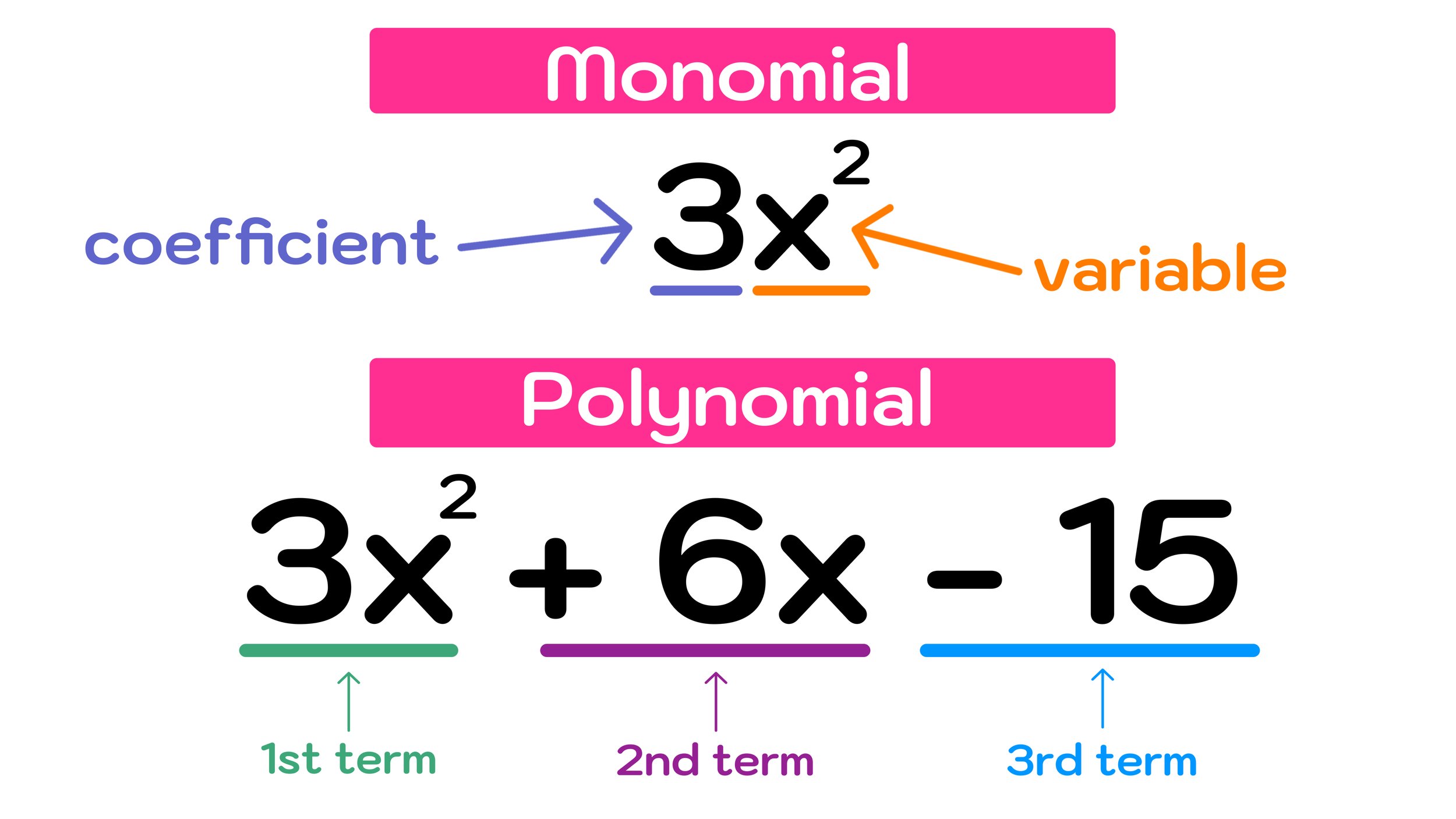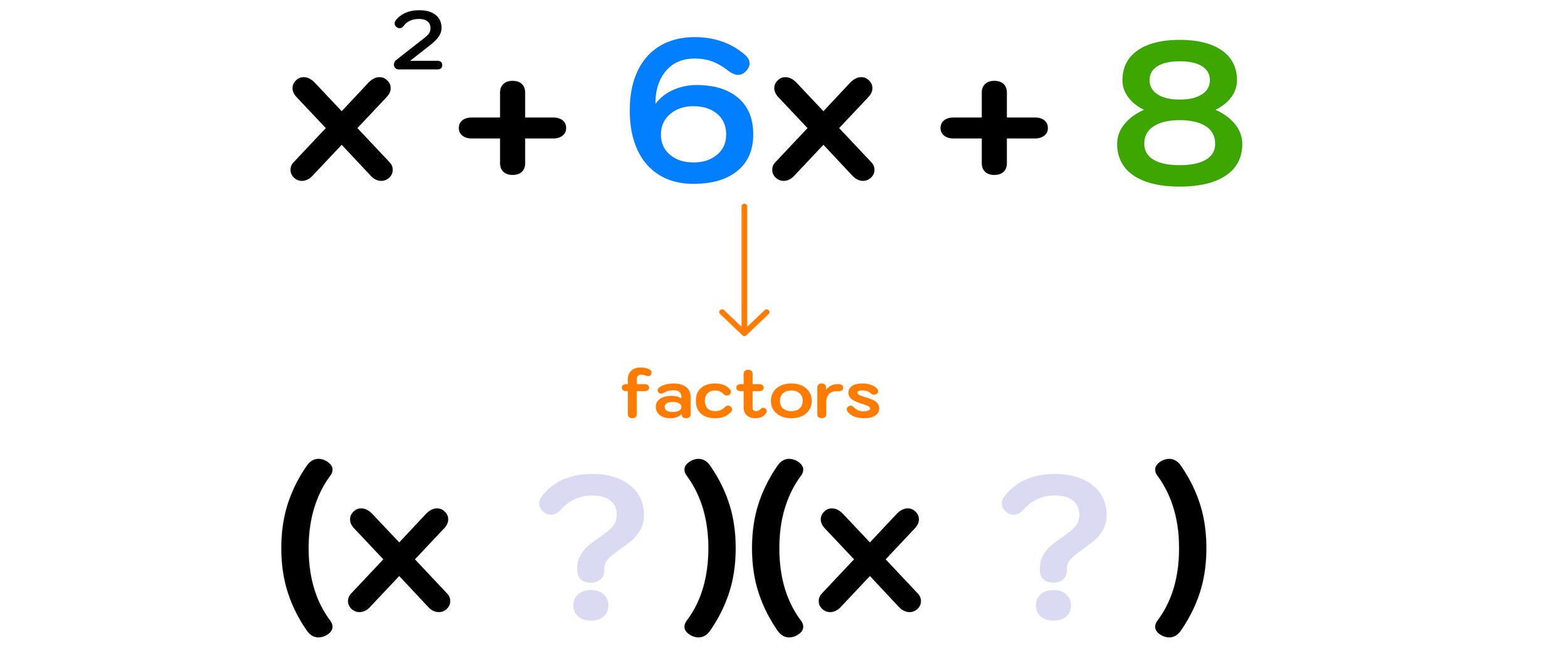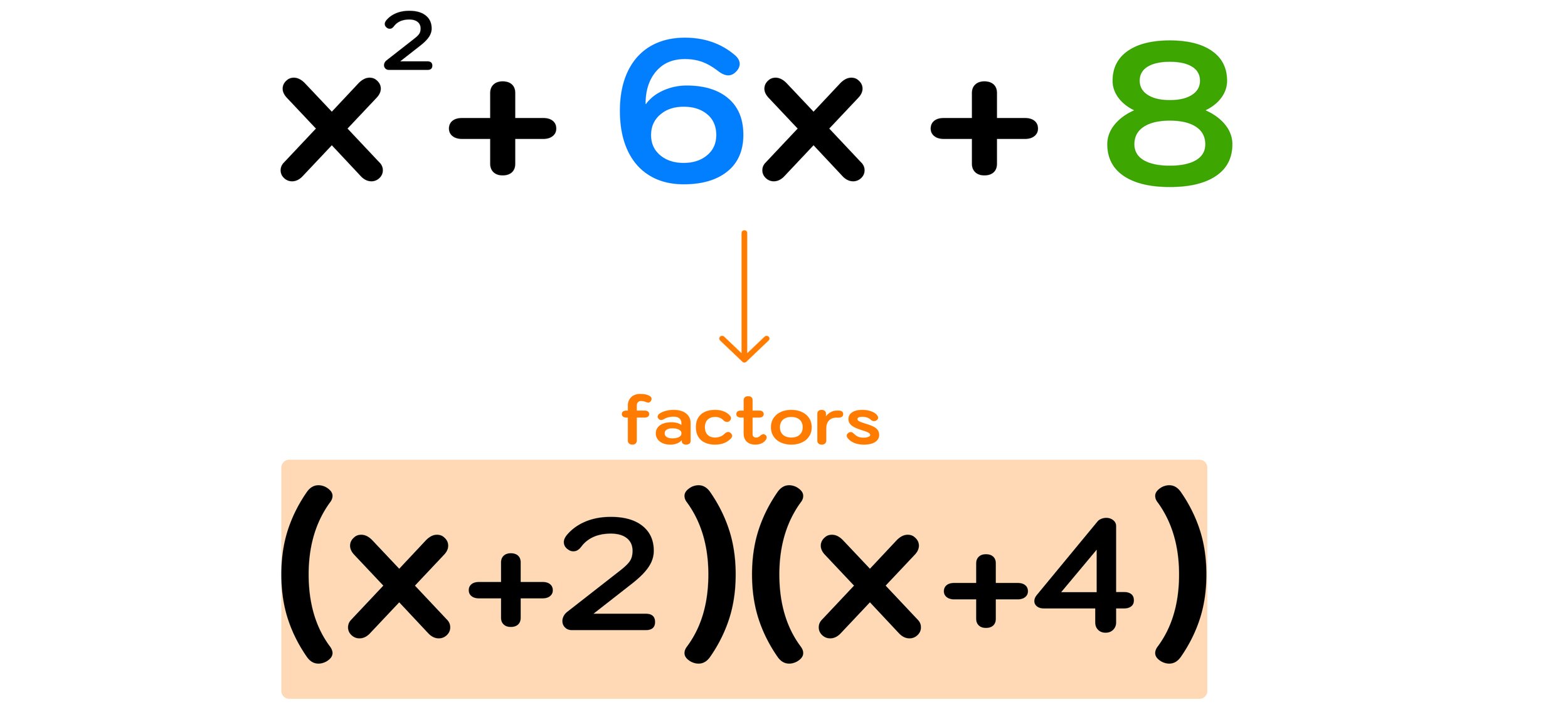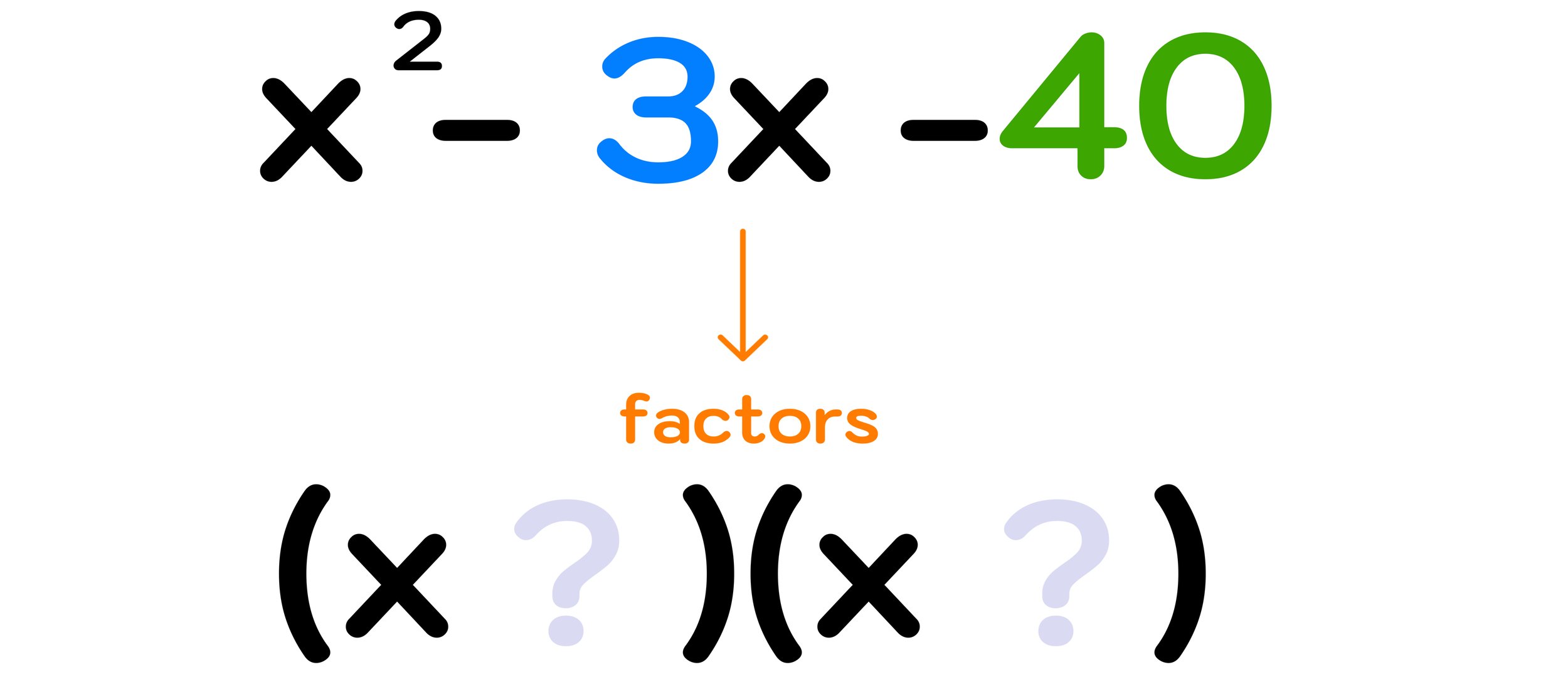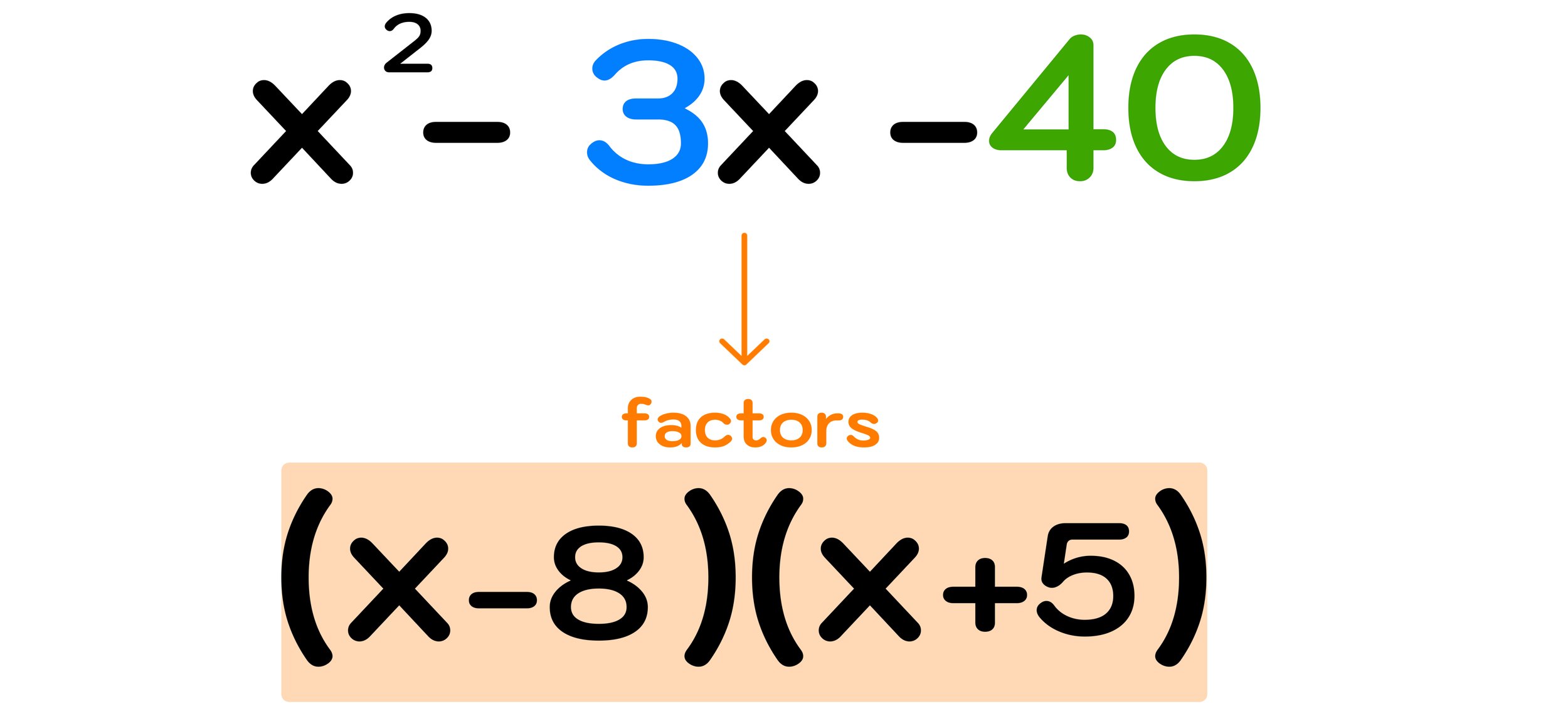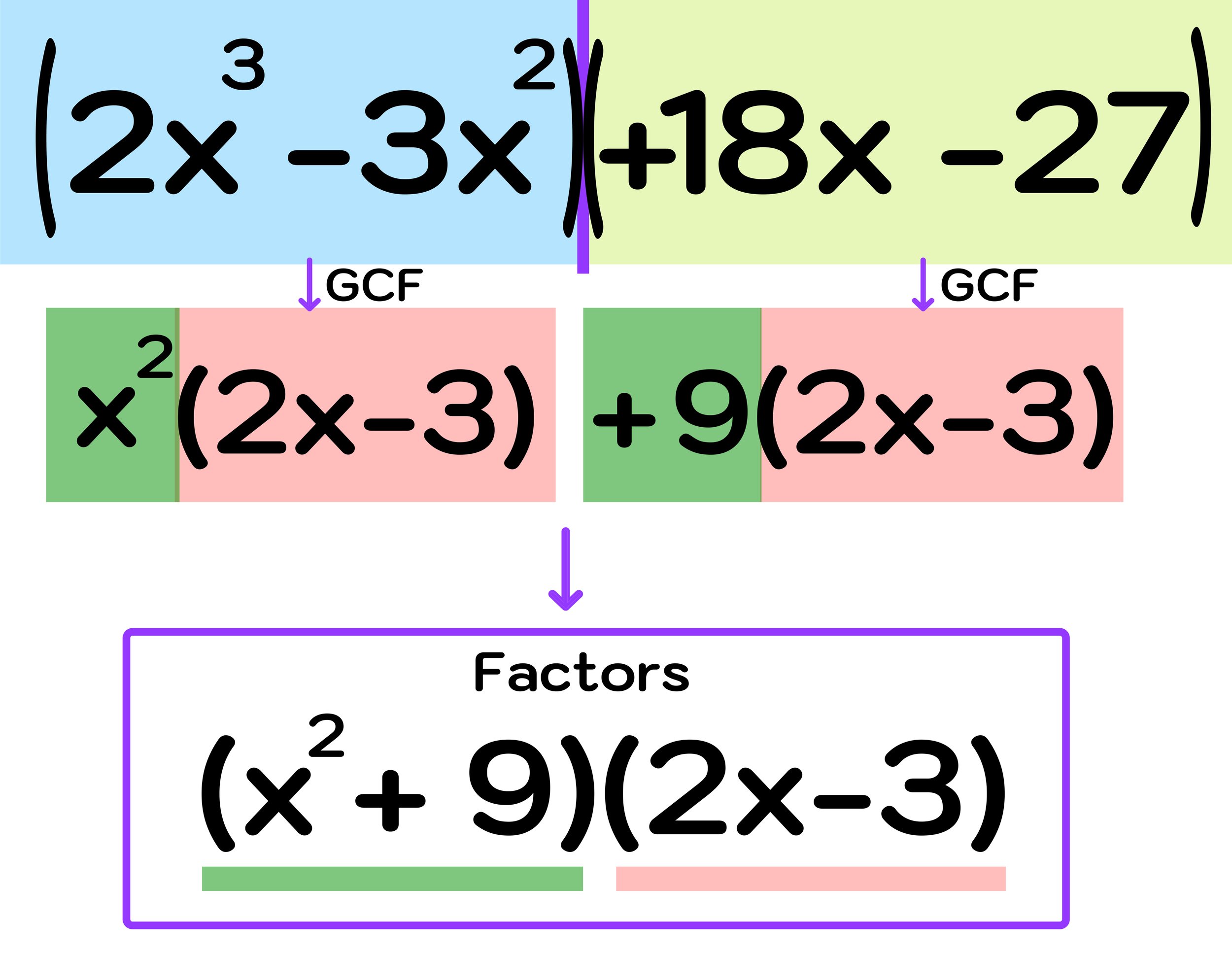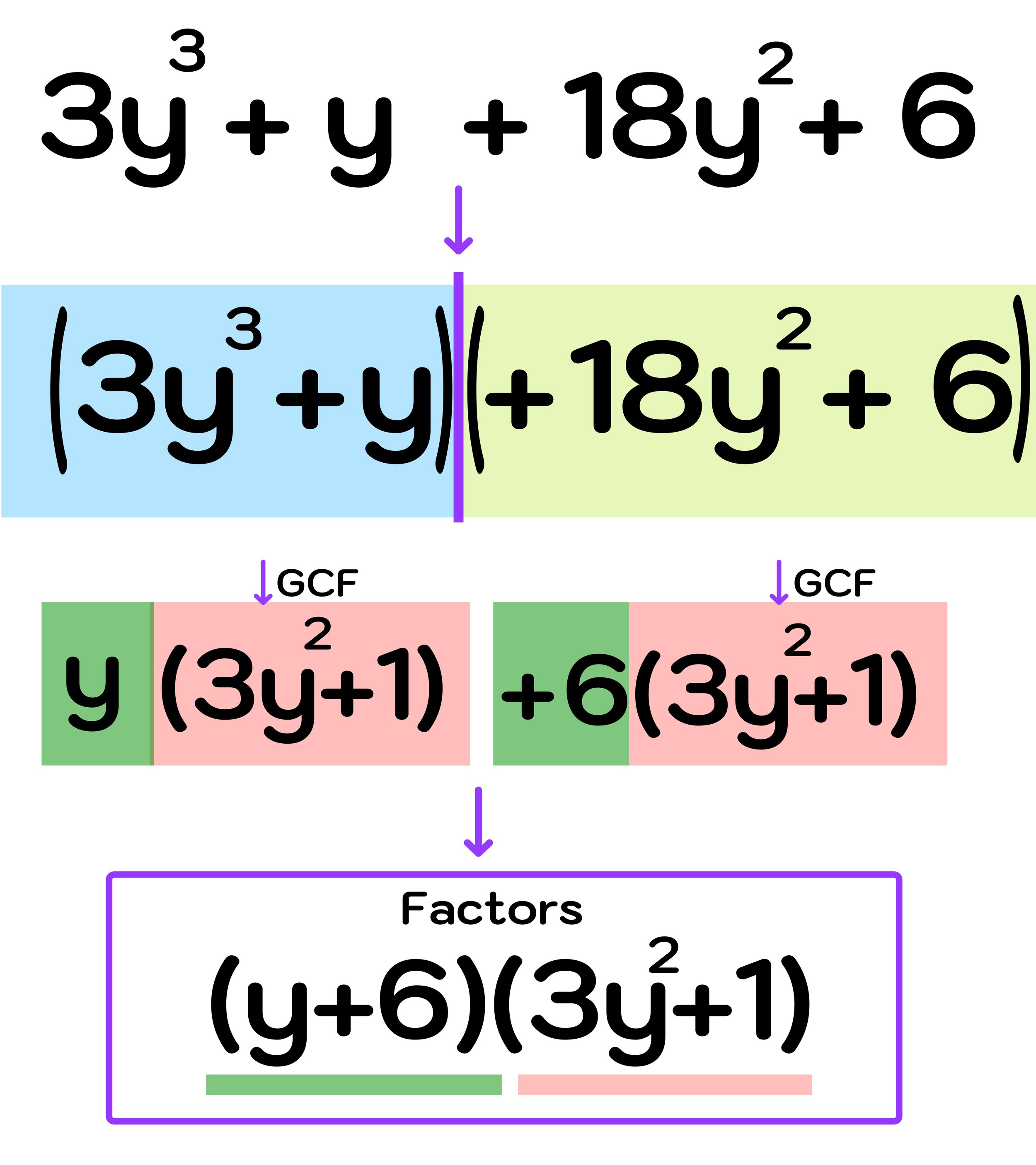How to Factor Polynomials Explained
Step-by-Step Guide: How to Factor Polynomials with 2 Terms, How to Factor Polynomials with 3 Terms, How to Factor Cubic Polynomials
In algebra, a polynomial is an expression made up of variables and coefficients separated by the operations of addition and/or subtraction.
Polynomials are a fundamental math topic and understanding how to work with them (including factoring) is essential to being successful in algebra and beyond. Learning how to factor polynomials with 2, 3, or 4 terms involves understanding how to break down a given polynomial into simpler factors.
This free Step-by-Step Guide on How to Factor Polynomials will cover the following topics:
How to factor polynomials with 3 terms (trinomials) when a=1?
How to factor polynomials with 3 terms (trinomials) when a≠1?
While learning how to factor polynomials can be challenging, it is a learnable skill that can be acquired through practice. The goal of this free guide on how to factor polynomials is to give you plenty of step-by-step practice with factoring polynomials—including polynomials with 4 terms (cubic polynomials)—so that can become more comfortable with factoring all kinds of polynomials.
Before we cover everything you need to know about how to factor a polynomial, let’s quickly recap some key algebra vocabulary terms and phrases that you will need to be familiar with in order to use this guide.
Figure 01: How to Factor Polynomials: What is a Polynomial?
What is a polynomial?
As previously stated, a polynomial is a math expression comprised of variables, coefficients, and/or constants separated by the operations of addition or subtraction.
The terms of polynomials are individual parts, or monomials, separated by addition or subtraction signs.
For example,
3x² is a monomial
3x² + 6x is a polynomial with 2 terms (3x² and 6x)
3x² + 6x - 15 is a polynomial with 3 terms (3x², 6x, and -15)
9x³ + 3x² + 6x - 15 is a polynomial with 4 terms (9x³, 3x², 6x, and -15)
Figure 01 above illustrates the difference between a monomial and a polynomial.
For an expression to be considered a polynomial, it must have at least two terms, but there is no limit on how many terms a polynomial can have.
When it comes to factoring polynomials, you will most commonly be dealing with polynomials that have 2 terms, 3 terms, or 4 terms:
A polynomial with 2 terms is called a binomial
A polynomial with 3 terms is called a trinomial
A polynomial with 4 terms is called a quadrinomial (also known as a cubic polynomial)
Examples of a polynomial with 2 terms, 3 terms, and 4 terms are shown in Figure 02 below.
Figure 02: How to factor polynomials with 4 terms or less.
Now that you understand the key terms and the difference between a polynomial with 2 terms, 3 terms, and 4 terms.
For factoring each type of polynomial, we will look at two methods: GCF, direct factoring, and a combination of the two.
Let’s get started!
How to Factor Polynomials with 2 Terms
We will start by learning how to factor polynomials with 2 terms (binomials).
Whenever you are factoring a polynomial with any number of terms, it is always best to start by looking to see if there is a GCF—or greatest common factor—that all of the terms have in common.
For example, consider the following example:
Example #1: Factor 8x + 4
For this example, you should notice that both terms, 8x and 4 are divisible by 4, hence they share a GCF of 4.
Therefore, you can divide out the GCF of 4 from both terms as follows:
8x + 4 → 4 (2x + 1)
So, the factors of 8x + 4 are: 4 and (2x+1).
What we just did was essentially the reverse of the distributive property, as shown in Figure 03 below.
Figure 03: How to factor a polynomial with 2 terms using the GCF method.
Note that many binomials can be factored using the GCF method, so let’s gain a little more practice with one more example (understanding how to simplify and/or factor a polynomial using the GCF method will come in handy when you start factoring 3 and 4 term polynomials later on).
Example #2: Factor 6x² + 12x
Just like the first example, there is a GCF for both terms. But, in this case, the GCF includes a variable. Why? Because both terms have coefficients that are divisible by 6 and both terms have at least one x variable, so the GCF, in this case, is 6x.
Therefore, you can divide out 6x from both terms as follows:
6x² + 12x → 6x(x + 2)
So, the factors of 6x² + 12x are: 6x and (x+2).
Again, this method of factoring is just the reverse of the distributive property and is illustrated in Figure 04 below.
Figure 04: How to factor a polynomial with 2 terms using the GCF method.
Next, we will look at a special case of factoring a binomial—when the binomial is a difference of two squares (this is sometimes referred to as DOTS).
Whenever you have a binomial of the form a²-b², the factors will be of the form (a+b)(a-b).
Example #3: Factor x² - 49
For example, if you wanted to factor the binomial: x² - 49, you would notice that both x² and 49 are squares:
x² = (x)(x)
49=(7)(7)
So, another way to write (x²- 49) is (x²- 7²)
Therefore, you can use the DOTS method for factoring binomials. In this case, a = x and b = 7, so:
(a²-b²) = (a+b)(a-b) → (x²- 7²) = (x-7)(x+7)
You can now conclude that the factors of x²- 49 are (x-7) and (x+7) using the DOTS method.
This process is illustrated in Figure 05 below:
Figure 05: How to factor a polynomial that is the difference of two squares.
If you want to learn more about the DOTS method for factoring polynomials that are the difference of two squares, check out this free video tutorial on YouTube for more practice.
And if you want more practice, check out our free Factoring Polynomials Worksheet Library, where you can download free PDF practice worksheets with answer keys.
Otherwise, let’s continue onto the next section where you will learn how to factor polynomials with 3 terms.
How to Factor Polynomials with 3 Terms
Moving on, we will now look at polynomials with 3 terms, typically referred to as trinomials
Learning how to factor polynomials with 3 terms involves a more involved factoring process that we will explore in this section.
The trinomials that we will cover will be of the form ax² + bx + c (where c is a constant). The strategies that we will use will depend on whether a (the leading coefficient) equals one or not. Therefore, the first two examples in this section will be factoring trinomials when a=1 and the second two examples will be when a≠1.
How to Factor Polynomials with 3 Terms when a=1
Example #1: Factor x² + 6x + 8
For the first example, we have to factor the trinomial: x² + 6x + 8
Figure 06: How to factor polynomials with 3 terms (when a=1)
Again, the leading coefficient, a, is equal to 1 in this example. This is important to note because the following method for factoring a trinomial only works when a=1.
Now we are ready to factor this trinomial in 3 easy steps:
Step One: Identify the values of b and c.
In this example, the values of b and c in the trinomial are: b=6 and c=8
Step Two: Figure out two numbers that both ADD to b and MULTIPLY to c.
The second step often involves some of trial-and-error as you pick numbers and see if they meet both conditions (the two numbers have to add together to make b and multiply together to make c).
5 + 1 =6 (the value of b) ✓
5 x 1 ≠ 8 (the value of c) ✘
For example, lets say that you chose the numbers 5 and 1. While 5+1=6 is true (satisfying the first condition), 5x1=5 (not 8), therefore, they do not satisfy the second condition. So, 5 and 1 do not work.
But, if you picked the numbers 2 and 4, you can see that:
2 + 4 =6 (the value of b) ✓
2 x 4 = 8 (the value of c) ✓
Since 2 and 4 satisfy both conditions, you can stop searching and move onto the third step.
Step Three: Use your numbers from step two to write out the factors
In this case, you can conclude that the factors of x² + 6x + 8 are (x+2) and (x+4).
Figure 07: The factors of x² + 6x + 8 are (x+2) and (x+4).
You can verify that these are the correct factors by performing double distribution as follows:
(x+2)(x+4) = x² + 2x + 4x + 7 = x² + 6x + 8
Notice that you ended up with the trinomial that you started with! Now, lets work through one more example of how to factor polynomials with 3 terms when a=1.
Example #2: Factor x² - 3x - 40
For this next example, we have to factor the trinomial: x² - 3x - 40
Figure 08: How to factor 3rd degree polynomials
Notice that, in this case, the trinomial includes subtraction signs, which will affect how you perform step two below.
Step One: Identify the values of b and c.
For this trinomial, b= -3 and c= -40
Step Two: Figure out two numbers that both ADD to b and MULTIPLY to c.
Again, you have to find two numbers that add to make -3 and that multiply together to make -40.
This part can be tricky when both of the values for b and c are negative (like in this example). You have to recall that a negative number times another negative number will lead to a positive result, so you can’t have two negatives (since you need to find two numbers that multiply together to make -40).
Eventually, after some trial-and-error, you should find that -8 and +5 satisfy both conditions:
-8 + 5 =-3 (the value of b) ✓
-8 x 5 = -40 (the value of c) ✓
Step Three: Use your numbers from step two to write out the factors
Finally, you can conclude that the factors of x² - 3x -40 are (x-8) and (x+5).
(You make sure that this answer is correct, you can perform double distribution on (x-8)(x+5) to make sure that the result is equal to the original trinomial).
Figure 09: The factors of x² - 3x -40 are (x-8) and (x+5).
If you want more practice factoring trinomials when a=1, check out our free step-by-step guide on how to factor trinomials to gain some more practice.
And if you want more independent practice opportunities, check out our free Factoring Polynomials Worksheet Library, where you can download free PDF practice worksheets with answer keys.
Otherwise, you can continue on to learn how to factor polynomials with 3 terms when a≠1.
How to Factor Polynomials with 3 Terms when a≠1
Example #1: Factor 2x² - x - 6
For the first example, we have to factor the trinomial: 2x² - x - 6
Figure 10: How to factor polynomials with 3 terms when a≠1
For starters, notice that you can not pull out a GCF.
So, to solve trinomials of the form ax² + bx + c when a≠1, you can use the AC method as follows:
Step One: Identify the values of a and c and multiply them together
In this case, a=2 and c=-6, so
a x c = 2 x -6 = -12
Step Two: Factor and replace the middle term
The second step requires you to use the result from step one to factor and replace the middle term.
The middle term is currently -1x and note that:
-12 = -4 x 3; and
-4 + 3 = -1
We chose -4 and 3 as factors because the sum of -4 and 3 equals negative 1, so we can rewrite the original trinomial as 2x² - 4x +3x - 6
Figure 11: Factor and replace the middle term
Step Three: Split the new polynomial down the middle and take the GCF of each side
Note that we are now working with a polynomial that actually has four terms: 2x² - 4x + 3x - 6
In this third step, you have to split the polynomial down the middle to essentially create two separate binomials that you can simplify by dividing GCF’s out of as follows:
First Half: 2x² - 4x = 2x(x-2)
Second Half: 3x - 6 = 3(x-2)
This third step is illustrated in Figure 12 below:
Figure 12: Split the new polynomial down the middle and take the GCF of each side
Step Four: Identify the Factors
Finally, you are ready to identify the factors.
The result from the previous step was 2x(x - 2) + 3(x -2). Hidden within this expression are your two factors, which you can see by looking at Figure 13 below.
Figure 13: The final step is to identify the factors
Finally, you can conclude that the factors of 2x² - x - 6 are (2x+3) and (x-2).
Clearly, factoring a trinomial when a≠1 can be a tricky and there are several steps along the way, but, the more that you practice this process, the better you will become at factoring polynomials with 3 terms like the one in this past example. To give you a little more practice, lets work through one more example before we move on to learning how to factor cubic polynomials.
Example #2: Factor 4x² - 15x + 9
Figure 14: Factor the trinomial where a=4, b=-15, and c=9
Step One: Identify the values of a and c and multiply them together
In this example, a=4 and c=9, so
a x c = 4 x 9 = 36
Step Two: Factor and replace the middle term
For the next step, note that the middle term is -15x, so you will need to find two numbers that multiply to 36 and add to -15:
36 = -12 x -3; and
-12 + -3 = -15
Now, we can rewrite the original trinomial as 4x² -12x -3x +9
Step Three: Split the new polynomial down the middle and take the GCF of each side
For step three, you have to split the polynomial into two separate binomials and divide a GCF out of each one as follows:
First Half: 4x² -12x = 4x(x-3)
Second Half: -3x+9 -3(x-3)
Step Four: Identify the Factors
The last step is to identify the factors as shown in Figure 15 below.
Figure 15: The factors are (4x-3)(x-3)
Now, you can conclude that the factors of 4x² - 15x + 9 are (4x-3) and (x-3).
You can again use double distribution on (4x-3)(x-3) to verify that your solution is correct.
If you need more step-by-step help with how to factor polynomials with 3 terms when a does not equal 1, visit out our free Factoring Polynomials Worksheet Library, where you can download free PDF practice worksheets with answer keys.
Otherwise, continue on to the final section where you will learn how to factor polynomials with 4 terms.
How to Factor Polynomials with 4 Terms
The last section of this guide will cover how to factor polynomials with 4 terms and how to factor cubic polynomials.
In this section, we are going to apply a grouping method for how to factor a cubic polynomial that is very similar to the way that you factored trinomials when the leading coefficient, a, did not equal one in the last section. So, you may want to review that section before moving onto the 4 term polynomial factoring examples, however, it is not completely necessary, as we will be taking a step-by-step approach to solving two examples of factoring cubic polynomials.
Now, lets go ahead and work through our first example on how to factor cubic polynomials.
Figure 16: Polynomials with 4 terms are referred to as cubic polynomials.
Example #1: Factor 2x³ - 3x² + 18x - 27
For the first example, we have to factor the cubic polynomial: 2x³ - 3x² + 18x - 27
Step One: Split the cubic polynomial into groups of two binomials.
To factor this 4 term polynomial, we are going to apply what is called the grouping method, which requires you to split the polynomial into two groups (two separate binomials) with the goal of factoring a GCF out of each one.
Figure 17: How to Factor Cubic Polynomials by Grouping: The first step is to split the polynomial into two groups of binomials.
Remember that the goal is to create two separate binomials that have a GCF. If there is no apparent GCF, you have the option of swapping the positions of the middle terms (- 3x² and 18x), but that is not necessary for factoring this 4 term polynomial.
In this example, by the end of step one, you now have two groups to factor:
(2x³ - 3x²)
(18x - 27)
Step Two: Factor each binomial by pulling out a GCF
Now, go ahead and divide a GCF out of each binomial as follows:
(2x³ - 3x²) → x²(2x - 3)
(18x - 27) → 9(2x - 3)
This step is illustrated in Figure 18 below.
Figure 18: How to factor a cubic polynomial by grouping.
Step Three: Identify the factors
Notice that both results have a (2x-3) term. This is important and expected. If both results do not share a same term, then you either made a mistake or the polynomial with 4 terms is not factorable.
But, since we were able to factor each group by pulling out a GCF that resulted in both groups sharing a common factor of (2x-3), we know that we can factor out the other terms (x² and +9), so now have our factors: (x²+9) and (2x-3)
Final Answer: The factors of 2x³ - 3x² + 18x - 27 are (x²+9) and (2x-3)
The entire process of how to factor polynomials by 4 terms by grouping is illustrated in Figure 19 below.
Figure 19: The factors of 2x³ - 3x² + 18x - 27 are (x²+9) and (2x-3)
Example #2: Factor 3y³ + 18y² + y + 6
Let’s gain some more practice with how to factor a cubic polynomial by grouping by solving one more example problem.
In this case, we have to factor the cubic polynomial 3y³ + 18y² + y + 6 using the same grouping method as the previous example.
Step One: Split the cubic polynomial into groups of two binomials.
Start by splitting the cubic polynomial into two groups (two separate binomials).
Figure 20: Split the cubic polynomial into two groups of binomials and check to see if they can both be factored by pulling out a GCF.
As shown in Figure 20 above, by completing step one, you are left with these two groups
(3y³ +18y²)
(y+6)
Hold on! Before moving onto the next step, you should notice that the second group (y+6) cannot be factored by pulling out a GCF (because there is no greatest common factor between 1y and 6).
However, notice that we can swap the middle terms of the cubic polynomial (18y² and +y) as shown in Figure 21 below.
Now, we can factor a new 4 term polynomial 3y³ + y + 18y² + 6 that is equivalent to the original 4 term polynomial since the commutative property of addition allows you to rearrange the terms.
Figure 21: The commutative property of addition allows you to rearrange the middle terms when you are unable to group and GCF the original cubic polynomial.
Notice that you can split this new polynomial into two binomials that can be factored by pulling out a GCF:
(3y³ + y)
(18y² + 6)
Figure 22: After rearranging the original cubic polynomial, you can split it into two binomial groups that can be factoring by pulling out a GCF.
Step Two: Factor each binomial by pulling out a GCF
As illustrated in Figure 22 above, after rearranging the original cubic polynomial, you can split it into two binomial groups that can be factoring by pulling out a GCF as follows:
(3y³ + y) → y(3y² + 1)
(18y² + 6) → 6(3y² + 1)
Step Three: Identify the factors
Now, you can see that both factors have a (3y² + 1) term, which means that you have factored correctly.
Final Answer: The factors of 3y³ + 18y² + y + 6 are (y+6) and (3y² + 1)
The entire process of how to factor polynomials a cubic polynomial like the one in this example is illustrated in Figure 23 below.
Figure 23: How to factor cubic polynomials by grouping (step-by-step).
Free Factoring Polynomials Practice Worksheets
If you want to further test your understanding of factoring polynomials, including the difference of two squares, factoring trinomials, factoring by completing the square, and factoring polynomials by grouping, then visit the Mashup Math Factoring Polynomials Worksheet Library, where you can download several free PDF practice worksheets with complete answer keys.
Click here to access our free Factoring Polynomials Worksheet Library.
How to Factor Polynomials: Conclusion
Learning how to factor a polynomial is an important algebra skill that every math student must learn at some point.
While factoring polynomials can be tricky, there are several useful and effective strategies that you can use to factor polynomials. The strategy that you choose will depend on how many terms a polynomial has (as you will often be dealing with factoring polynomials with 2, 3, or 4 terms).
The best way to get better at factoring polynomials (especially cubic polynomials that have 4 terms) is by working through practice problems step-by-step. If you feel like you need more practice, we highly recommend working through the examples in this guide several times to gain more experience.
Keep Learning:



